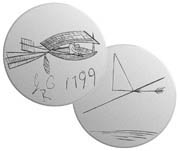 Sir George Cayley has been described as the 'Father of Aerial Navigation'. One hundred years before the Wright Brothers he had developed the first proper understanding of the principles of flight and constructed a series of models to prove his ideas. In 1853, fifty years before the first powered flight was made at Kitty Hawk, the first man-carrying glider flight was made across Brompton dale in the north of England by Cayley's coachman.
Sir George Cayley has been described as the 'Father of Aerial Navigation'. One hundred years before the Wright Brothers he had developed the first proper understanding of the principles of flight and constructed a series of models to prove his ideas. In 1853, fifty years before the first powered flight was made at Kitty Hawk, the first man-carrying glider flight was made across Brompton dale in the north of England by Cayley's coachman.
 Cayley defined the form of the present day aeroplane by breaking away from the previous ideas of how powered flight would be achieved. The drawing he made on a silver disc in 1799 shows a machine with a fixed wing, a fuselage, and a tail. It also had separate systems to provide lift, propulsion and control. Cayley later tried to develop the 'prime mover' that he realised would be needed for powered flight, but unfortunately his gunpowder engines were not reliable.
Cayley defined the form of the present day aeroplane by breaking away from the previous ideas of how powered flight would be achieved. The drawing he made on a silver disc in 1799 shows a machine with a fixed wing, a fuselage, and a tail. It also had separate systems to provide lift, propulsion and control. Cayley later tried to develop the 'prime mover' that he realised would be needed for powered flight, but unfortunately his gunpowder engines were not reliable.
 He carried out the first serious, experimentally based aeronautical research, and the reverse side of the disc shows Cayley's analysis of the forces on a wing surface into lift and drag components. This represented a significant step in our understanding of flight, and in 1804 Cayley followed it up with experiments using a 'whirling arm', the first ever scientific testing of aerofoils.
He carried out the first serious, experimentally based aeronautical research, and the reverse side of the disc shows Cayley's analysis of the forces on a wing surface into lift and drag components. This represented a significant step in our understanding of flight, and in 1804 Cayley followed it up with experiments using a 'whirling arm', the first ever scientific testing of aerofoils.
